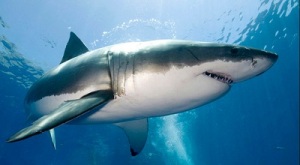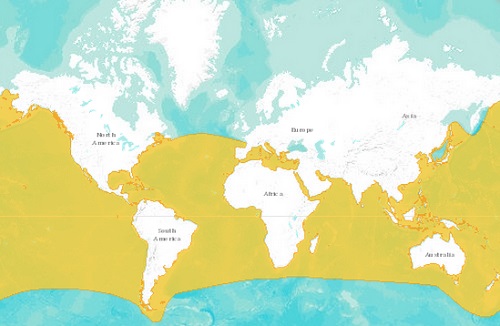0
Taxonomy

Great White Shark in the National Aquarium in Washington DC. This species is considered vulnerable by the IUCN Red List of Threatened Species.
- Kingdom: Animalia
- Phylum: Chordata
- Class: Chondrichthyes
- Order: Lamniformes
- Family: Lamnidae
- Genus: Carcharodon
- Species: Carcharodon carcharias
Name
- Common name: Great white shark, white shark, white pointer or great white.
- Scientific name: Carcharodon carcharias.
0
Physical Features
- The white shark has a dorsal fin on top of its body, two pectoral fins at the bottom front and rear and a caudal fin. In addition they have two small fins at the pelvic level which gives them the aerodynamic and efficient glide in the water reaching speeds of up to 35 mph or 50 km/h.
- White sharks belong to the class of chondrichthyes which have cartilage instead of bones.
- The dorsal color varies from light to dark gray.
- The great white shark has large triangular shaped teeth. They are serrated so that they can bite their prey. The bottom teeth are narrower. They have 300 teeth in up to 7 rows which they lose regularly but continue to be replaced.
- They breathe through 7 gill slits on either side of their bodies.
- They have endothermic bodies meaning that their bodies are warmer than the water in which they swim.
- White sharks have six senses: smell, hearing, sight, taste, touch and electromagnetism.
Habitat and Distribution
- Great white sharks have a large geographical range. They are found within 60 degrees north to 60 degrees south latitude in the Americas, Asia, Europe, Africa and Oceania and in all major seas except for the Antarctic.
- They live in temperate and subtropical waters between 54˚ and 75˚ F or 12˚C and 24˚C.
- Their distribution in North America ranges from Newfoundland in Canada to Florida in USA in the east coast. In the west coast from Alaska in the north to Mexico in the south.
- One of the highest concentration of great white sharks is around Gyer Island in South Africa.

Great white shark map distribution. Source: IUCN Red List of Threatened Species.
Size and Length
- Their length average is 15 feet or 4.6 meters and can measure up to 20 feet or 6 meters.
- They weigh up to 5,000 pounds or 2,268 kilos.
Reproduction
- Female great white sharks reach reproductive maturity at 15 years old while males at 10.
- Incubation lasts 12 months.
- Litter size varies from 2 to 10.
- White sharks are ovoviviparous. The embryo develops and hatches within the mother’s body feeding from the yolk.
- The young are born life and measure from 3.5 to 5 inches or 1 to 1.5 meters.
- After pups are born they are able to feed on their own.
Behavior
- The white shark is the largest predator in the marine ecosystem. It is at the top of the food chain.
- They are social animals who cooperate and hunt in groups. They are naturally curious.
- It is believed that their electromagnetic receptor is used for communicating but it has not been proven.
- Breaching is a behavior that white sharks show to hunt. They approach their victim and suddenly attack from deep below giving its prey no chance to escape. The shark then shakes its head from side to side usually killing its victim.
- Most research is done in South Africa. There is still no clear understanding of its behavior, habitat needs and migration patterns. This is due to the difficulty in observing them in their natural habitat.
- Electronic tags attached to them show that they can swim thousands of miles a year.
- Attack on humans typically happen near the shore at 10 to 30 feet deep.
Diet
- Carnivore, opportunistic eaters. They eat seals, sea lions, fish, carrion, sea turtles and other sharks. They are apex predators and are on top of the food chain.
- They use their sense of sight and smell to hunt.
Threats
- The great white shark matures slowly, reaching reproductive age at 15 and produce few offspring.
- Populations are slow in recovering where they have been depleted.
- Poaching sharks for its fins. Shark fin soup is a delicacy in Asia cuisine.
- By catch is the accidental death or injury by getting caught in fishermen nets or lines.
- Sea pollution.
Life Expectancy
- Great white sharks can life up to 60 years.
Conservation
- It is illegal to hunt great white sharks in Australia, Namibia, New Zealand, Malta, South Africa and USA.
- The IUCN lists the great white shark as a “vulnerable” species.
Did you know?
More than 70 percent of victims of Great White Shark Attacks survive because the shark realizes it has made a mistake and lets the victim go.
References and further research
Marine Biology Conservation Society
Natural History Magazine – Natural Killer
ReefQuest Center for Shark Research
Florida Museum of National History – Ichthyology
California Academy of Science – Shark Advice
Pelagic Shark Research Foundation
